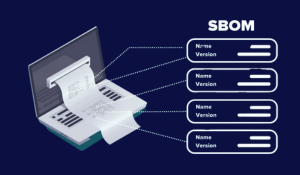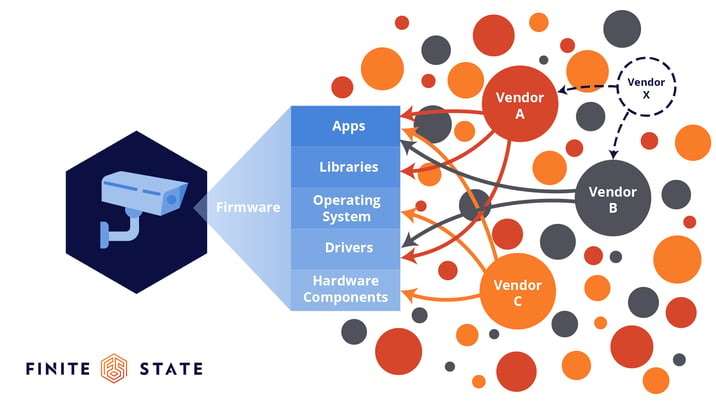Introduction
With the rising frequency and sophistication of cyberattacks targeting software supply chains, developers face a daunting challenge: how to mitigate supply chain risks effectively without negatively impacting efficiency and innovation.
Any disruption to the supply chain can significantly impact a company’s operations, reputation, and bottom line, which is why supply chain risk management has quickly become a critical aspect of business strategy.
One tool that plays a key role in supply chain risk management is the Software Bill of Materials (SBOM). In this article, we’ll explore what an SBOM is, how it contributes to supply chain risk management, the barriers to adoption and best practices for implementing SBOMs, and take a look at trends impacting the future of SBOMs.
What is SBOM?
A Software Bill of Materials (SBOM) is a comprehensive list of a software product’s components and dependencies. It provides a detailed inventory of all the third-party and open-source components used in a software product, including their versions, licenses, and known vulnerabilities.
The purpose of an SBOM is to provide transparency and visibility into the software supply chain. The detailed report allows organizations to understand the components and dependencies in use, identify potential risks, and take proactive measures to mitigate those risks.
In other words, when new vulnerabilities are reported, SBOMs make it easy to determine whether they affect your software.
How is an SBOM different from other software inventory tools?
Unlike traditional software inventory tools, which provide a list of installed software on a device, SBOMs go one step further, providing a detailed breakdown of the components and dependencies within each software product.
While many organizations use software asset management (SAM) tools to manage software licenses and usage, SBOMs provide more detail, making them an effective all-in-one tool for managing supply chain risk and compliance.
4 ways SBOMs contribute to software supply chain risk management
In recent years, high-profile cyberattacks targeting software supply chains have underscored the urgent need for enhanced supply chain risk management practices. Examples include the SolarWinds breach (2019), which penetrated thousands of organizations globally, including multiple departments of the US federal government, and the Codecov supply chain attack (2021).
SBOMs, while not a complete solution to software supply chain security, play a vital role. Let’s look at four ways they contribute to effective software supply chain risk management in more detail.
1. SBOMs identify vulnerabilities and risks
SBOMs play a pivotal role in mitigating supply chain risks by giving developers and stakeholders greater visibility into the software components they rely on. By analyzing the SBOM, organizations can identify known vulnerabilities, outdated libraries, or risky dependencies that could expose their systems to exploitation.
This visibility enables teams to proactively approach software supply chain security, prioritizing timely patching or remediation actions that will address potential vulnerabilities before malicious actors can exploit them.
2. SBOMs help with open-source license management and compliance
When we think of risk management, our first thought often goes to vulnerabilities. However, non-compliance with licensing agreements can also affect a software supply chain, which is where a software bill of materials can help.
An SBOM allows organizations to track and manage their software usage and ensure compliance with licensing agreements by providing a comprehensive list of all components and licenses.
SBOMs are particularly important for projects using open-source components, which, according to research by Gitnux is more than 96% of applications!
3. SBOMs facilitate open communication and collaboration
Another way SBOMs contribute to supply chain risk management is by facilitating communication and collaboration between different teams within an organization. With an SBOM, development and security teams can clearly understand the software components and dependencies, allowing for better communication and collaboration on potential risks and vulnerabilities.
By sharing an SBOM with suppliers and customers, organizations can also demonstrate their commitment to supply chain risk management and build trust with their partners.
4. SBOMs enable informed decision making
The final way that SBOMs can contribute to supply chain risk management that we’ll look at today is their impact on decision-making. Developers can use the information about a software’s components and dependencies in an SBOM and compare known vulnerabilities to a vulnerability database, like Finite State’s, to assess threat levels. Armed with this knowledge, they can prioritize fixes that will offer the most security bang for their buck (particularly important for teams with limited resources).
Software bill of materials barriers to adoption
Despite the significant benefits of SBOMs, their widespread adoption faces several challenges.
One notable challenge is the lack of standardized formats for SBOMs, which leads to interoperability issues and compatibility challenges across different tools and platforms. Fortunately, this challenge is being addressed through the introduction of CycloneDX and SPDX formats, which are quickly becoming the go-to SBOM formats across industries.
Additionally, organizations may encounter resistance from stakeholders within the supply chain, including software vendors, who may be reluctant to disclose detailed information about their software components. This reluctance often stems from concerns about exposing the “secrets” that make their products unique or risks around exposing sensitive data.
Overcoming this resistance requires fostering a culture of transparency and collaboration across the supply chain and emphasizing the shared responsibility for supply chain security.
How can organizations implement SBOMs?
The most time-efficient and cost-effective way to create an SBOM is to use an automated tool like the one Finite State offers. These tools scan a software product and generate an SBOM automatically, using standardized formats that make managing and distributing the reports easier.
Tools like Finite State can also provide ongoing monitoring and updates to ensure the SBOM remains accurate and up-to-date. This monitoring happens automatically, reducing the burden on your development team significantly.
To ensure the successful implementation of SBOMs, it’s essential to integrate it with your existing vulnerability management processes. Finite State offers a complete software supply chain security solution that combines SCA, SBOM, and patented AI-powered attack surface reduction technology to secure software supply chains from development through to production.
Examples of SBOM implementation across industries
As a result of President Biden’s Executive Order in May 2021, many US government departments, including the Department of Defense (DoD) and the General Services Administration (GSA), have proposed new rules requiring federal contractors to develop and maintain SBOMs for any software used to deliver a contract.
But government contractors aren’t the only ones required to use software bills of materials. The automotive industry was one of the earliest adopters of SBOMs. In 2018, the Automotive Information Sharing and Analysis Center (Auto-ISAC) released a set of guidelines for automotive companies to implement SBOMs in their supply chain risk management practices. These guidelines recommend using SBOMs to identify and mitigate potential risks in the software components used in vehicles (which, if you’ve bought a new car recently, you’ll know is a lot!).
Another sector that’s successfully implemented SBOMs is the healthcare industry. The U.S. Food and Drug Administration’s (FDA) 2019 draft guidance recommended the use of SBOMs in medical devices, a requirement that became mandatory in 2023. This is largely in response to the number of cyber incidents in recent years that have impacted the healthcare industry, particularly medical devices. The new rules are designed to help organizations identify and mitigate potential risks in software components, ultimately improving patient safety and data protection.
Emerging SBOM trends
Looking ahead, the future of SBOMs holds significant promise for enhancing supply chain risk management and strengthening software security. Emerging technologies such as blockchain and distributed ledger technology (DLT) offer new opportunities for securely storing and sharing SBOMs, enabling immutable audit trails and enhancing trust in software supply chains.
Furthermore, continued advancements in artificial intelligence (AI) and machine learning (ML) present opportunities for further automating SBOM generation and analysis, reducing the manual effort required by developers and improving the accuracy of risk assessments.
Conclusion
In conclusion, SBOMs represent a critical tool for enhancing supply chain risk management in software development. By providing transparency, accountability, and visibility into software components’ origins and dependencies, SBOMs enable organizations to identify and mitigate supply chain risks proactively.
However, realizing SBOMs’ full potential requires overcoming adoption challenges, addressing privacy concerns, and embracing emerging technologies and collaborative initiatives.
As software supply chain attacks continue to pose a significant threat to organizations worldwide, prioritizing SBOM adoption and integration into development workflows is essential for safeguarding against supply chain vulnerabilities and ensuring the security and integrity of software products.
Subscribe to Our Blog
Get the latest posts delivered straight to your inbox weekly.
Share this
You May Also Like
These Related Stories

How SBOM Management Ensure Software Supply Chain Security

SBOMs: The Accurate Guide to Software Supply Chain Security



